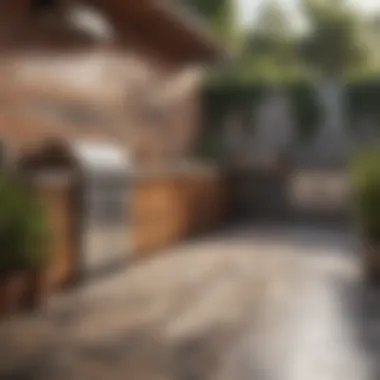Choosing the Right Tile for Outdoor Kitchens


Intro
Outdoor kitchens have carved out a significant niche in contemporary home design. As these culinary spaces merge seamlessly with nature, they invite a range of aesthetics and practical considerations. The choice of tile stands out as a critical factor that not only enhances visual appeal but also impacts functionality and maintenance. Selecting the right tile material, color, and pattern is akin to choosing the right ingredients for a fine dish; it can elevate the entire experience and bring joy to outdoor gatherings.
In this article, we explore how outdoor kitchen tiles serve as more than just finishes; they act as foundational elements that shape the character of these versatile spaces. From rugged stone to sophisticated ceramic, each tile type offers unique benefits and challenges, making careful consideration paramount. By understanding the importance of tile selection, homeowners, designers, and real estate professionals can significantly influence both the style and longevity of outdoor cooking areas.
As we delve deeper, we'll also touch on current trends in outdoor kitchen tiles and how they weave into the broader landscape of home design.
Preamble to Outdoor Kitchens
Creating an outdoor kitchen is about more than just whipping up a meal in the fresh air; it’s about embracing a lifestyle that connects your home with nature and your culinary passions. An outdoor kitchen does wonders for a home, enhancing both its functionality and ambiance. An effectively designed cooking space outdoors can be a magnet for family gatherings, lazy weekend barbecues, or an intimate evening with friends, fostering both experiences and memories.
The incorporation of outdoor kitchens has seen a steady rise in popularity due to shifting lifestyle preferences. More homeowners are leaning towards entertaining at home, often opting for spaces that extend their kitchen's physical and social reach. With this trend, the choice of materials becomes critical, as you want your outdoor kitchen to reflect your style and withstand varying weather conditions.
Defining Outdoor Kitchens
At its core, an outdoor kitchen typically includes key elements like grills, countertops, and seating areas, bridging the gap between cooking and outdoor living. Basically, you could call it the best of both worlds. Think of a space that embodies convenience and aesthetics—like having a kitchen without the walls. In many cases, these setups can even incorporate shade structures or even a full-fledged roof, depending on your home design and climate.
The beauty of outdoor kitchens lies in their adaptability. Whether your space is expansive or modest, it can be tailored to fit the available area and your personal needs. Some homeowners may opt for a complete setup with an oven and refrigerator while others might prefer a simple grill and prep space. This flexibility ensures that the outdoor kitchen remains a bespoke solution for any home.
Trends in Outdoor Cooking Spaces
As the outdoor cooking trend continues to evolve, several patterns have caught on, enhancing how these spaces are designed and used. For instance:
- Sleek and Modern Designs: Homeowners are choosing minimalistic, clean lines that align with contemporary aesthetics. Think stainless steel appliances, polished stone surfaces, and a focus on integrated technology.
- Sustainable Features: With an increased awareness of environmental issues, many new outdoor installations include energy-efficient grills and water-saving fixtures. Rainwater harvesting systems and solar-powered lights are becoming common sights.
- Mix and Match Materials: There’s a noticeable shift away from traditional materials. Mixing tiles, wood, and even metal enhances creativity and adds an eclectic touch to outdoor areas.
- Outdoor Living Areas: It’s not just about cooking anymore. People are incorporating lounge spaces, fire pits, and dining areas, creating a full outdoor experience.
"Outdoor kitchens bring versatility and style to your backyard, expanding your living space and enriching the culinary experience."
In summation, defining an outdoor kitchen today involves much more than just the basics. It’s a blend of function meeting design, where homeowner preferences dictate style trends, making it a dynamic field within home design. The evolving definition also reflects the changing attitudes toward cooking and entertaining, pushing the boundaries of what an outdoor culinary space can achieve.
Importance of Tile in Outdoor Kitchens
When it comes to outdoor kitchens, the choice of tiles isn't just a matter of aesthetics; it directly impacts functionality, safety, and maintenance. Quality tile can transform a simple cooking area into a stylish, inviting space. Moreover, it endows the area with the durability needed to withstand the elements, which is crucial for outdoor environments that experience various weather conditions.
Aesthetic Appeal
The visual impact of tile cannot be overstated. The right tile can be the cherry on top of an outdoor kitchen design. With countless options in colors, sizes, and finishes, homeowners can easily make a bold statement or complement existing design elements. For example, a slate tile with its rich textures and shades can bring warmth and earthiness, making it perfect for gardens or patios. Additionally, incorporating mosaic patterns adds an element of charm, serving both to attract the eye and to personalize the space.
- Enhancing Cohesion: When selecting tiles, consider the overall landscape. Colors that resonate with nature can blend seamlessly with the greenery surrounding a patio area.
- Patterns and Textures: Experimenting with different finishes like matte vs. glossy can create unique visual effects. A mix of textures not only looks appealing but also offers practical benefits—textured tiles often provide better grip, reducing the risk of slips.
Durability and Functionality
Tiles are not just pretty faces; they are the backbone of outdoor kitchen design due to their robust nature. When selecting the right tiles, homeowners should focus on materials that can withstand the wear and tear of outdoor conditions. For example, porcelain tiles are highly resistant to moisture, stains, and scratches, making them ideal for outdoor surfaces that experience heavy use.
- Seasonality Concerns: Extreme temperature changes can take a toll on low-quality tiles; hence investing in high-caliber options is vital.
- Maintenance Benefits: Many outdoor tiles are easy to clean and require minimal upkeep. A quick rinse with soap and water tends to suffice, allowing you to spend more time enjoying your outdoor oasis than cleaning it.
Safety Considerations
When it comes to outdoor kitchens, safety should be a top priority. Selecting appropriate tiles can help minimize hazards like slips and falls, especially when surfaces are damp. Using textured tiles can significantly enhance grip, ensuring that individuals feel secure when moving around the cooking area.
"Safety is not just about choosing the right surface; it's about creating a worry-free cooking and entertaining environment."
- Heat Resistance: Outdoor tiles, especially those designed for cooking areas, should also be able to withstand high temperatures. Materials such as natural stone or specific porcelain types offer great heat resistance, making them ideal for placement near grills or outdoor ovens.
- Non-toxic Options: It's also wise to consider the chemicals that might have gone into the production of your tile. Opting for non-toxic and eco-friendly tiles can contribute to a safer outdoor environment, especially for families with young kids or pets.
In summary, the role of tile in outdoor kitchens is multifaceted—enhancing aesthetics, offering durability, and prioritizing safety. Homeowners who pay attention to these details when designing their outdoor culinary spaces will find themselves with more than just a cooking area; they’ll create a harmonious extension of their home.
Types of Tiles for Outdoor Kitchens
In the realm of outdoor kitchens, tiles play a pivotal role in both aesthetic and practical capacities. The selection of tile types is not just about setting the stage for culinary creations; it's about creating an inviting atmosphere that harmonizes with the surrounding environment. Each type of tile boasts its unique traits, benefits, and considerations. Understanding these can help homeowners make informed decisions that align with their design vision and functional requirements.
Ceramic Tiles
Ceramic tiles are often the go-to choice for outdoor kitchens due to their versatility and affordability. They come in an array of colors and designs, offering something to suit every taste. Their easy-to-clean surface makes ceramic tiles particularly appealing for outdoor spaces where spills are likely.


Benefits of Ceramic Tiles
One of the standout features of ceramic tiles is their durability. They can withstand the elements quite well, remaining resilient against rain and sun. Additionally, these tiles are resistant to moisture, which is a major advantage for outdoor settings. Homeowners also appreciate the variety of styles available, enabling them to match their kitchen's aesthetic perfectly.
- Cost-effective: Generally speaking, ceramic tiles are budget-friendly.
- Variety of Designs: They can mimic other materials like wood or stone, opening up design possibilities.
Nevertheless, while their durability is commendable, they can be prone to chipping under heavy impact, which is something to keep in mind when selecting ceramic for high-traffic areas.
Potential Drawbacks
On the flip side, ceramic tiles have their weaknesses. Although they are not as porous as some other materials, they can still absorb water if not properly sealed. This characteristic raises concerns in regions with significant freezes where moisture trapped within can cause cracking. Another drawback is their tendency to fade in direct sunlight over time, thereby losing some of their visual appeal.
Porcelain Tiles
Porcelain tiles are commonly favored for outdoor kitchens that demand a higher level of performance. Unlike ceramic, porcelain has a denser structure that enhances its durability even further. This quality makes them an excellent choice for outdoor applications, where they can endure more than just everyday wear and tear.
Advantages of Porcelain
The standout attribute of porcelain tiles is their water and stain resistance. They feature a low absorption rate, which makes them less susceptible to moisture-related issues. Porcelain tiles combined with their aesthetic appeal can emulate natural stone, providing homeowners with a chic option without the hefty price tag. Moreover, they’re less likely to chip in comparison to ceramic, offering a more resilient surface.
- Heat Resistance: They can handle higher temperatures, making them perfect for outdoor cooking environments.
- Long-lasting: With proper care, they can last for decades.
Still, this durability often comes with a higher price tag, which is an important consideration as homeowners budget for their outdoor space.
Cost Considerations
When contemplating the installation of porcelain tiles, cost is undeniably a vital factor. The price of tiles can vary widely based on design, size, and quality. While they may be an investment upfront, the longevity and reduced maintenance requirements can present a cost-effective solution over time. Additionally, one must consider installation labor, which can add significantly to the overall expense, especially for intricate patterns.
Natural Stone Tiles
Natural stone tiles, such as granite, slate, and travertine, are often considered the epitome of luxury in tile choices. Each stone tile has its unique aesthetics due to the characteristics of the natural material. This can create an enchanting look in an outdoor kitchen that feels both sophisticated and grounded.
Varieties of Natural Stone
Natural stone tiles vary in composition and appearance, providing a plethora of options. Granite is prized for its strength and heat resistance, making it an excellent choice for cooking areas. Slate, on the other hand, offers a unique texture and color variations that enhance visual interest.
- Trendy Options: Travertine’s earth tones can blend seamlessly with a natural landscape.
- Environmentally Friendly: Many homeowners opt for stone tiles because they are natural materials.
However, some varieties are more porous than others, which necessitates sealing to prevent stains and damage.
Maintenance Needs
The maintenance of natural stone tiles is crucial for preserving their beauty. Regular sealing can mitigate staining, but this adds an extra step to upkeep. Homeowners should budget for periodic maintenance along with the initial cost of installation. In regions where weather can be more unpredictable, the risks associated with porous stones can mean more maintenance investment is needed to preserve the beauty and performance of the tiles.
Glass Tiles
Glass tiles bring a modern flair to outdoor kitchens, offering a desirable visual impact. Their reflective surface can make spaces feel larger and more open, which is often a goal in small outdoor areas. They serve as a colorful backdrop to culinary activities, contributing to a lively ambiance.
Visual Impact
What sets glass tiles apart is their brilliance and range of colors. They can be used as accents or for entire surfaces, providing an eye-catching element to the design. Glass tiles resist stains and are easy to clean, making them a practical option for busy outdoor kitchens.
- Creative Flexibility: Their shapes and sizes allow for unique design patterns.
- Light Reflection: Glass tiles can brighten dark spaces effectively.
The downside? They're slippery when wet, which can be a safety issue in outdoor settings where food and water frequently mingle.
Environmental Aspects
Regarding environmental considerations, glass tiles often score higher because they are typically made from recycled materials. This eco-friendly aspect is appealing to homeowners who value sustainability. However, the initial costs can be steep, and potential buyers must assess whether the long-term benefits outweigh these upfront expenses.
"In the world of outdoor kitchens, selecting the right tile isn’t just a choice; it’s a commitment to creating an environment that’s functional, beautiful, and enduring."
Choosing the right tile type for an outdoor kitchen requires careful thought about aesthetics, durability, cost implications, and maintenance needs. Each tile option brings its strengths and weaknesses, offering homeowners and designers the opportunity to create a space tailored to their individual lifestyles.
Choosing the Right Tile


Choosing the right tile plays a pivotal role in the overall functionality and aesthetics of an outdoor kitchen. This isn’t merely about picking something that looks good; it's about evaluating various vital elements that contribute to the long-term success of this space. Homeowners often face a myriad of options, and making an informed choice can enhance not only the visual appeal but also the practicality of the kitchen area.
Assessing Climate Considerations
Climate is a critical factor to consider when selecting tiles for an outdoor kitchen. Different materials react uniquely to weather conditions. For instance, if you're living in a region that has blistering heat, it might be wise to avoid darker tiles, as they tend to absorb more heat, making the kitchen uncomfortably warm. Conversely, in regions with cold winters, some materials can crack due to freezing temperatures. Hence, understanding your local climate can guide you toward tiles that will stand the test of time, saving you from potential headaches down the line.
Integrating with Existing Landscaping
Integrating the tile choice with existing landscaping is an essential step in achieving a cohesive design. Your outdoor kitchen should feel like a part of the landscape, not an afterthought. For example, if your yard features earthy tones and natural stone, opting for tiles that mimic these elements can create harmony. Tiles that blend seamlessly with the plants and structures around can elevate the scene magnificently, ensuring your outdoor space is both functional and beautiful.
Color and Pattern Selection
Neutral Tones vs. Bold Colors
When it comes to color selection, it can seem like a toss-up between neutral tones and bold colors. Neutral tones are popular for a reason: they offer a versatile backdrop and allow for flexibility in decor. They provide a sophisticated and timeless aesthetic, making it easier to change the outdoor furniture whenever you feel like a refresh. On the flip side, bold colors can inject personality and excitement into the outdoor kitchen. Vibrant tiles can become a statement piece that showcases individuality. However, one must carefully evaluate how these colors fit into the wider outdoor scheme; too bold might clash with the natural surroundings.
Pattern Mixing Advice
Then comes the art of pattern mixing. It’s becoming all the rage to combine different tile patterns to create unique designs. However, while it may sound appealing, it requires a delicate touch. Choosing patterns that complement rather than compete can be a worthwhile endeavor. For example, pairing a geometric pattern with soft, muted Moroccan tiles can create an inviting and spirited atmosphere. The trick here is to ensure there’s a common thread—whether it be color or texture—that unifies diverse designs. This not only adds depth but can make the outdoor kitchen a visual delight.
"Choosing the right tile can genuinely make or break your outdoor kitchen experience; it’s more than just a surface. It’s about lifestyle!"
In summary, the complexities surrounding tile choice for outdoor kitchens extend beyond mere aesthetics. By keeping climate considerations, landscape integration, and color-pattern blending in mind, homeowners can craft a space that marries beauty and function, enhancing both the outdoor culinary experience and the overall design of their homes.
Installation Techniques for Outdoor Tiles
When considering an outdoor kitchen, the installation techniques of tiles hold substantial importance in ensuring not just aesthetic appeal but also long-term durability and functionality. These techniques can make a world of difference, influencing everything from the longevity of the tiles to how well they withstand elements ranging from UV rays to rainfall. A good installation is like a solid foundation for a house; without it, nothing stands strong in the face of challenges.
One key benefit of focusing on installation methods is that they determine the ability of outdoor kitchen tiles to resist weather fluctuations and heavy foot traffic. Proper installation helps in preventing water damage and the wear and tear caused by direct exposure to nature. Also, when done right, it simplifies maintenance routines later on. With just a little foresight to tackle these technical aspects, you can guarantee that your investment remains beautifully intact over the years and performs its duties effectively.
Foundation Preparation
Before laying down any tiles, one needs to prep the foundation adequately. This step involves leveling the ground and ensuring proper drainage, which are fundamental to tile integrity. Without a level base, tiles may shift or crack, leading to costly replacements down the line. You might think of it like baking a cake; get the base wrong, and no icing can hide the flaws!
- Assess soil conditions: Checking for moisture levels and soil type can make a big difference. Compacted soil will suffice, but sandy soil might require additional stabilization.
- Drainage: Ensuring that water does not pool is important. Install appropriate drainage systems or slopes that allow water to run off.
- Base layer: Using gravel or a concrete slab can serve as the perfect base. This not only enhances stability but also prevents weeds from interfering with your outdoor kitchen's appearance.
Tile Layout Planning
Tile layout planning requires a mix of creativity and practicality. Before sticking a tile down, it’s wise to visualize your layout. This foresight can help prevent mismatched patterns or awkward cuts that detract from the overall look.
- Grid method: It’s often easiest to start in the center and work your way out, but depending on your design, sometimes a radial or a linear layout might be more suitable.
- Dry layout check: Lay out the tiles without adhesive first to see how they fit together. Measure twice, cut once applies here. You want to visualize how the design flows.
- Consider borders or accents: Think about how colors or patterns in your tiles can create focal points or guide the eye throughout the space.
Grouting and Finishing
Once tiles are laid, the next task is grouting, which seals the gaps and provides structural integrity. A well-done grout job stops dirt and moisture from forming between tiles, which could lead to damage over time.
, "A meticulous grouting process is not just for aesthetics; it truly is the guardian of outdoor tile longevity."
- Type of grout: Choose the correct grout based on the tile material. For outdoor kitchen tiles, a flexible grout can allow for movement.
- Application technique: Use a rubber float to push grout into the joints while scraping off excess. It's an art and a bit of elbow grease!
- Sealing: Once the grout dries, a sealant protects the grout lines and enhances longevity.
In summary, installing outdoor kitchen tiles is a multifaceted process that deserves careful attention. With proper foundation preparation, strategic tile layout planning, and diligent grouting and finishing, your outdoor kitchen can not only become a beautiful extension of your home but also remain resilient against outdoor challenges.
Maintenance of Outdoor Kitchen Tiles
Maintaining outdoor kitchen tiles is not just about aesthetics; it plays a crucial role in ensuring the longevity and functionality of these surfaces. Outdoor spaces are often subjected to the elements, which can cause wear and tear over time. Proper maintenance can prevent the need for costly repairs or replacements and keeps the kitchen looking its best throughout the seasons. By establishing a routine for care and cleaning, homeowners can enjoy their outdoor kitchens without the added stress of deterioration.
Routine Cleaning Practices
Regular cleaning is the cornerstone of tile maintenance. It helps prevent buildup of dirt, grease, and organic matter that can tarnish the visual appeal of your outdoor kitchen. Simple, effective practices can go a long way. For basic upkeep, routine cleaning should include:
- Sweeping: Remove loose debris regularly to prevent scratches.
- Mopping: Use warm water mixed with mild detergent to wipe down surfaces, avoiding harsh chemicals which might damage grout or tiles.
- Rinsing: Immediately rinse any spills, especially acidic or sticky substances like vinegar or juice, to prevent stains and etching.
Creating a schedule, like a light clean once a week and a more thorough clean monthly, can help keep the tiles pristine without being overwhelming.


Preventing Damage
When it comes to tiles, prevention is always better than cure. Taking proactive steps to protect your outdoor kitchen significantly reduces the risk of damage over time. Here are specific aspects to consider:
Dealing with Stains
Stains can be the bane of any outdoor cook. They not only mar the beauty of the tiles but can also degrade their material integrity if left untreated. The key characteristic of dealing with stains is understanding their source. Different spills require different methods:
- Food and Grease Stains: Using a specialized degreaser or a mixture of baking soda and water can help lift stubborn residues.
- Organic Stains: For stains like wine or fruit juice, a mixture of hydrogen peroxide and water is effective.
The unique feature of dealing with stains is the variety of methods one can employ. While some people may lean towards chemicals, others might prefer natural alternatives. The advantage of tackling stains quickly is that it minimizes potential long-term damage and keeps the outdoor kitchen in top shape, creating an inviting atmosphere for gatherings.
Addressing Cracks
Cracks can occur as tiles settle or due to environmental changes, but addressing them swiftly can prevent bigger issues. The key aspect of addressing cracks is identifying the cause and applying the correct repair method. For minor cracks, using a grout or epoxy filler is typically efficient. If the crack is deeper and affects the tile itself, replacement might be necessary.
The unique feature of addressing cracks lies in the options available. Homeowners may choose to patch, which is cost-effective, or replace the tiles entirely, which ensures uniformity in appearance. The advantage of prompt attention to cracks is that it not only maintains the visual integrity but also prevents water intrusion, which can lead to more extensive damage beneath the surface.
"Keeping your outdoor kitchen tiles in peak condition isn't merely a matter of pride; it's a fundamental aspect of home stewardship."
By being attentive and implementing these maintenance strategies, homeowners can ensure their outdoor kitchens remain a source of pride and a functional space for years to come.
Innovative Designs in Outdoor Tiling
When it comes to creating outdoor kitchens, tile plays a pivotal role that goes beyond the mundane elements of functionality and protection. Innovative designs in outdoor tiling not only provide practical benefits but also deepen the aesthetic experience of these spaces. In the context of home design, incorporating unique tile styles can transform a simple cooking area into a lavish retreat. Considerations like the choice of materials, patterns, and textures all contribute to setting the tone, making it essential to explore various innovative approaches.
The strong visual impact of innovative tiling designs can elevate the overall ambience of your outdoor kitchen. For homeowners and designers alike, the goal is to achieve a perfect blend of form and function. Additionally, unique tile patterns can act as conversation starters, encouraging gatherings and entertaining.
More than just a pretty face, these tile designs must be durable enough to withstand outdoor elements. Thus, selecting innovative tile options means looking into materials that can hold up against moisture, heat, and even the occasional scratch. The interplay of color and light reflects the beauty of nature while allowing the kitchen to feel integrated into its surroundings.
Mosaic Patterns
Mosaic patterns have stood the test of time as a favorite choice in outdoor tile design. These intricate designs can bring a level of artistry that ordinary tile simply can’t match. A mosaic can be anything from small, vibrant tiles arranged in a captivating design to more sophisticated motifs that tell a story or reflect personal style. The beauty of using mosaics is in their versatility.
- Visual appeal: Mosaics can breathe life into dull outdoor spaces, creating focal points like backsplashes or tabletops that draw the eye.
- Customizability: Homeowners can customize their mosaics with specific colors or themes, making it easy to combine personal tastes with the existing landscape.
- Installation: While generally more complex than traditional tile installation, the effort often leads to remarkable return on investment in terms of aesthetic value.
However, it’s essential to choose materials wisely. Not every tile—ceramic, porcelain, or stone—is suitable for mosaics in an outdoor setting due to their exposure to weather changes.
Textured Tiles
Textured tiles, on the other hand, offer a more tactile experience, making them an increasingly popular choice for outdoor kitchens. These tiles provide both style and safety, ensuring that even when wet, surfaces remain slip-resistant. The rugged surfaces can evoke a natural feel, complementing outdoor settings beautifully.
- Safety first: Textured tiles help prevent slips when wet, making them a prudent option for high-traffic areas.
- Natural look: Many textured tiles replicate natural materials such as wood or stone, enhancing the organic aesthetics of your outdoor kitchen.
- Unique designs: The variety of textures available—ranging from rough to smooth—allows homeowners to make bold design choices without sacrificing functionality.
When selecting textured tiles, it's vital to balance between feel and appearance. Look for designs that not only appeal visually but are also designed to endure the rigors of an outdoor setting.
"Innovative tile designs not only enhance the aesthetics but also elevate the functionality and safety of outdoor kitchens."
Cost Implications of Outdoor Kitchen Tiles
Understanding the cost implications related to outdoor kitchen tiles is crucial for homeowners and designers alike. It’s not only about selecting a tile that looks pleasing; practical considerations related to budget play a significant role in the decision-making process. Investing in the right materials can lead to a space that serves its function while enhancing the overall ambiance of your outdoor cooking area.
When it comes to outdoor kitchens, the expenses do not end merely with the purchase of the tiles. One must consider various factors that contribute to the overall cost. From the quality of materials to labor costs, these elements all intertwine to create a comprehensive financial picture. This section will delve into the impact of material costs and installation expenses, offering a framework for effective budgeting.
Material Costs
The variety of materials available for outdoor kitchen tiles leads to a wide range of pricing structures. Factors that affect material costs include:
- Type of Tile: Certain materials like natural stone can be pricier due to their unique qualities, whereas ceramic or porcelain tiles typically fall on the lower end of the spectrum.
- Quality and Finish: High-quality finish tiles often come with a higher price tag, but they can offer better durability and aesthetic appeal.
- Source and Brand: Sourcing tiles from well-known brands may boost the price, reflecting quality assurance and the brand's reputation.
Selecting the right material hinges on your long-term goals. For instance, while you might save a few bucks opting for less expensive tiles, they might not withstand weather conditions as robustly as higher-quality alternatives. A cheaper tile could lead to costly repairs down the line, potentially impacting the overall budget further. It's often said, "Penny wise, pound foolish," reinforcing the idea that skimping on quality may not be financially savvy in the long run.
Installation Expenses
Once you’ve settled on the tile material, it’s time to consider installation costs, which can vary enormously based on the following:
- Labor Costs: Hiring professionals often brings with it a higher price, especially if they are specialists experienced in installing outdoor tiles. Experience pays off, as the job's quality can protect your investment.
- Complexity of the Layout: If the design includes intricate patterns or unique features, expect to pay more. A simple grid layout will likely cost less in terms of labor compared to a custom mosaic.
- Preparation Work: Don’t forget that your outdoor space might need groundwork or adjustments before tile installation. This additional prep work can contribute to overall expenses as well.
Ultimately, budgeting for your outdoor kitchen tile isn’t just about the initial outlay. Keep in mind that high-quality tiles, coupled with skilled installation, can provide both beauty and longevity, ensuring the space is functional and appealing for years to come.
Key Takeaway: Investing judiciously in materials and ensuring professional installation can save you money in repairs or replacements down the line—an outcome every homeowner desires.















